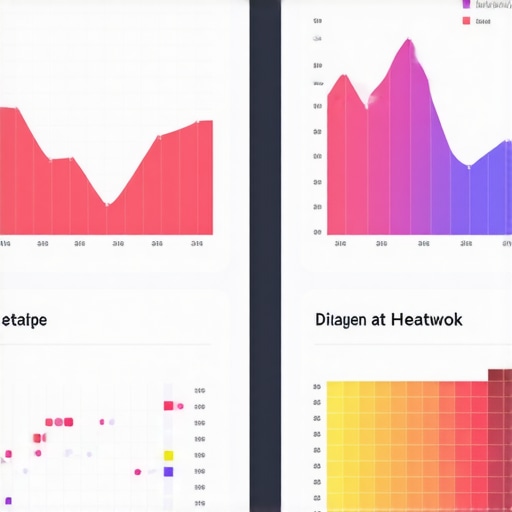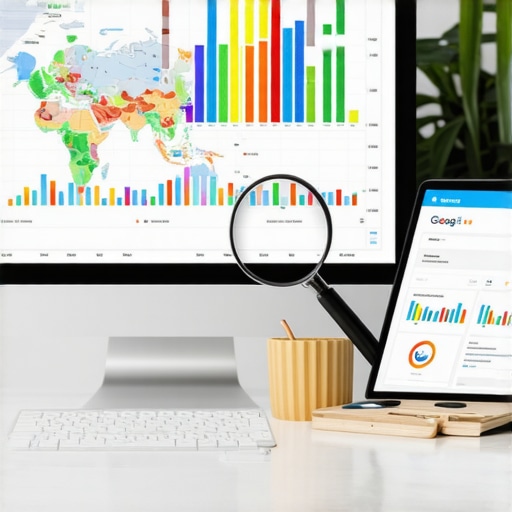Unlocking the Depths of Maps SEO: An Expert Perspective on Google Visibility Optimization
In the rapidly evolving landscape of local search, mastering Maps SEO and enhancing Google visibility have become critical for businesses aiming to dominate their niche. As an industry veteran, I recognize that traditional optimization tactics are no longer sufficient; instead, a nuanced approach rooted in data-driven strategies and technical finesse is essential to secure top-tier rankings here.
Decoding the Complexities of Local Search Algorithms
Google’s local search algorithm is a sophisticated interplay of multiple signals, including relevance, proximity, and authority. Advanced practitioners leverage semantic SEO techniques, integrating LSI keywords that mirror user intent, thus optimizing map listings for diverse search queries. Understanding these elements allows for tailored strategies that elevate your local presence.
How can businesses leverage structured data for Maps SEO success?
Structured data markup, such as Schema.org, significantly enhances search engines’ understanding of your business information. Implementing local business schema can improve visibility in rich snippets and Google Maps results, providing a competitive edge. Industry reports from white papers emphasize that structured data increases click-through rates and improves ranking stability.
What are the emerging trends shaping future Google Maps rankings?
Emerging trends include the integration of AI-driven insights, voice search optimization, and the importance of user-generated content. Staying ahead requires continuous adaptation, such as optimizing for voice queries and managing online reviews proactively. These insights are supported by recent studies from Search Engine Land.
How can local businesses effectively measure and adapt their Maps SEO strategies?
Utilizing tools like Google Search Console and local rank trackers allows businesses to monitor key metrics, analyze user interactions, and refine their approach dynamically. Regular audits and competitor analysis ensure sustained visibility and ranking improvements.
For comprehensive guidance, explore top Google visibility tips for 2024 and learn how to implement proven tactics effectively. Engaging with these advanced strategies can significantly elevate your local search dominance, positioning your business at the forefront of your industry.
To deepen your understanding, consider contributing insights or questions to expert forums, fostering a community of knowledge sharing that accelerates collective growth in Maps SEO mastery.
Harnessing the Power of Local SEO Data Analytics for Superior Google Maps Rankings
In the competitive realm of local search, harnessing sophisticated data analytics tools can be a game-changer. Leveraging platforms like Google My Business Insights and third-party analytics solutions enables businesses to uncover nuanced customer behavior patterns, optimize their service areas, and refine keyword targeting. These insights, when integrated into your Maps SEO strategy, drive smarter decision-making and amplify your visibility in local searches.
What role does AI-driven personalization play in local search optimization?
Artificial Intelligence is revolutionizing how search engines interpret user intent and personalize results. For local businesses, integrating AI tools that analyze user reviews, click patterns, and engagement metrics can help craft hyper-relevant content and optimize listing attributes. This, in turn, enhances your chances of appearing prominently in personalized search results. Industry experts have highlighted how AI algorithms are increasingly influencing Google’s ranking signals, making it essential to adapt your optimization efforts accordingly here.
Visualizing your local SEO data through dynamic dashboards can reveal hidden opportunities. Incorporate heatmaps of user interactions or heat maps of search trends in your targeted geographical zones to identify high-opportunity neighborhoods or underserved areas. Employing these visual tools enables more strategic placement of your resources and content.
How can you leverage emerging voice search technologies to stay ahead in Maps SEO?
With voice search accounting for a growing share of local queries, optimizing for conversational keywords and natural language phrases becomes increasingly vital. Incorporate long-tail keywords that mimic spoken language, and ensure your NAP (Name, Address, Phone Number) details are consistent across all platforms. Voice-optimized content also benefits from structured data, such as FAQ schema, to improve voice search compatibility.
For a comprehensive approach, explore effective Maps SEO techniques that incorporate voice search optimization to boost your Google Maps rankings effectively. Staying ahead of these technological trends is crucial for maintaining visibility.
Have you experimented with integrating AI or voice search strategies into your local SEO efforts? Share your experiences or ask questions in the comments below, and let’s deepen our collective understanding of future-proof Maps SEO tactics.
Harnessing the Power of Hyper-Local Content for Elevated Maps Visibility
While technical optimization forms the backbone of effective Maps SEO, the strategic deployment of hyper-local content can be a game-changer. Advanced practitioners craft content that resonates specifically with neighborhood-specific events, landmarks, and community interests. This granular focus not only boosts relevance in local searches but also fosters community engagement, encouraging organic backlinks and reviews from local sources. For instance, creating blog posts about upcoming local events or partnerships with neighborhood organizations can significantly enhance local relevance and authority, thereby improving rankings.
Implementing Dynamic Geofencing Strategies to Capture Real-Time Search Intent
Geofencing technology allows businesses to deliver targeted content and offers to users within a specific geographical boundary. When integrated into your Maps SEO strategy, real-time geofencing can capture the search intent of users actively in your vicinity. For example, a restaurant could trigger promotional notifications to users within a 500-meter radius during peak hours, subtly influencing their decision-making process. Leveraging geofencing analytics can reveal patterns in user behavior, enabling hyper-targeted ad campaigns and content personalization that directly impact local search visibility.
How does leveraging user-generated content influence long-term Maps SEO resilience?
Authentic user-generated content (UGC), such as reviews, photos, and Q&A, is a crucial component of a resilient Maps SEO strategy. Advanced tactics involve incentivizing customers to share detailed reviews and multimedia content, which enriches your profile and signals trustworthiness to search engines. Moreover, integrating UGC into your website and social media channels creates a robust ecosystem of fresh, relevant content that sustains engagement and rankings. Research from Moz indicates that businesses with active review profiles experience up to 20% higher click-through rates, demonstrating UGC’s impact on visibility and credibility.
What are the cutting-edge tools for real-time analytics and predictive modeling in local search?
Emerging tools such as AI-powered local analytics dashboards and predictive modeling platforms enable businesses to anticipate search trends and optimize proactively. These platforms analyze vast datasets, including search volume fluctuations, review sentiment shifts, and competitor movements, to forecast future ranking opportunities. For example, tools like BrightLocal’s Local Search Rank Checker and SEMrush’s Position Tracking incorporate machine learning to provide actionable insights, allowing businesses to adjust their strategies before ranking drops occur. Staying ahead with these technologies is essential for maintaining a dominant local presence.
In what ways can voice-activated AI assistants reshape local search optimization tactics?
Voice-activated AI assistants are transforming how users engage with local search, emphasizing conversational and intent-driven queries. Advanced optimization involves tailoring content to match natural language patterns, such as long-tail, question-based keywords, and ensuring NAP consistency across all voice-enabled platforms. Additionally, integrating voice-friendly schemas like FAQ schema and optimizing for featured snippets can dramatically enhance your chances of appearing in voice search results. Industry reports from Gartner suggest that by 2025, over 50% of searches will be voice-activated, underscoring the importance of integrating these tactics into your overall Maps SEO framework.
How can businesses harness AI to personalize local search experiences and boost loyalty?
AI-driven personalization tailors search results, recommendations, and offers based on user behavior, preferences, and contextual data. For instance, machine learning algorithms analyze review histories, engagement patterns, and social media activity to deliver hyper-relevant content that encourages repeat visits and fosters loyalty. Implementing AI chatbots on your business profile to answer common queries promptly can also improve user experience and review scores. As personalization becomes more sophisticated, integrating AI in your Maps SEO strategy will be vital for differentiating your brand in competitive local markets.

Unlocking the Next Level of Maps SEO: Harnessing AI and Machine Learning for Hyper-Local Targeting
In the pursuit of local search supremacy, integrating cutting-edge AI and machine learning techniques offers a formidable advantage. These technologies enable real-time analysis of search patterns, review sentiment, and consumer behavior, empowering businesses to adapt swiftly and precisely. For instance, deploying predictive analytics can anticipate shifts in local demand, allowing for strategic content and service adjustments that position your brand ahead of competitors. Industry insights from Search Engine Land underscore the importance of embracing these innovations to sustain visibility.
How can Structured Data and Rich Snippets Elevate Map Listings?
Structured data, especially Schema.org markups, serve as the backbone for enhanced search result presentation. Implementing advanced schemas such as Service, Product, or Offer types enables your listings to display rich snippets, including star ratings, menus, or booking options. These visual enhancements not only attract clicks but also reinforce trustworthiness, ultimately boosting rankings. The authoritative Google Developers resource provides comprehensive guidelines for leveraging structured data effectively.
Why is Voice Search Optimization Critical for Future-Proof Maps SEO?
With voice search’s exponential growth, optimizing for conversational queries and natural language becomes imperative. Focus on long-tail keywords, questions, and local intent phrases, while ensuring NAP consistency across all platforms. Integrating FAQ schema and featured snippets positions your business to capture voice-driven traffic, which is expected to constitute over half of all searches by 2025, according to Gartner estimates. Advanced voice optimization strategies can significantly increase your visibility in this evolving landscape.
What Role Do User Engagement Metrics Play in Algorithmic Ranking?
Metrics such as click-through rate (CTR), dwell time, and review activity serve as vital signals to Google’s local search algorithms. Enhancing user engagement involves crafting compelling, local-specific content, optimizing images, and encouraging authentic reviews. Employing heatmaps and interaction analytics reveals user preferences and helps refine your local SEO tactics. Regularly monitoring these metrics with tools like Google Analytics and BrightLocal ensures your strategy remains aligned with evolving ranking factors.
How Can Hyper-Local Content and Community Integration Drive Organic Authority?
Developing content tailored to neighborhood landmarks, events, and community stories fosters deep connections with local audiences. Collaborations with neighborhood organizations and participation in local initiatives generate backlinks and reviews, reinforcing authority. For example, sponsoring local festivals and creating related blog content elevates your relevance and trust within the community, thereby amplifying your Maps SEO performance.
What Advanced Geofencing Techniques Can Capture Real-Time Search Intent?
Implementing sophisticated geofencing strategies allows hyper-targeted advertising and content delivery within specific zones. By analyzing user behavior and foot traffic data, businesses can tailor offers and notifications to users in proximity, influencing immediate decision-making. This real-time responsiveness enhances user experience and increases the likelihood of conversions, directly impacting local search prominence.
How does Customizing AI-Powered Personalization Improve Local Search Results?
Personalized search experiences driven by AI analyze user history, preferences, and contextual signals to deliver highly relevant results. For local businesses, leveraging AI personalization can optimize content recommendations, review responses, and service suggestions, fostering loyalty and repeat visits. Integrating these advanced personalization tactics into your Maps SEO strategy ensures your business remains top-of-mind in local searches.
Leveraging Visual Content to Strengthen Maps SEO Impact
High-quality images and videos embedded in your Google My Business profile significantly enhance user engagement and trust. Visual content that showcases your premises, products, or community involvement can improve CTR and encourage sharing. Incorporating visual storytelling aligned with local themes creates a compelling narrative that resonates with your audience, elevating your overall local search visibility.
Are You Ready to Implement These Cutting-Edge Maps SEO Techniques?
Adopting these sophisticated strategies requires a proactive approach and continuous learning. Stay informed through reputable sources like Moz and industry webinars, and consider collaborating with local SEO specialists to tailor tactics to your unique market. Embrace these innovations to secure a dominant position in local search results and drive sustained growth.

Expert Insights & Advanced Considerations
1. The Power of Hyper-Local Content Customization
Crafting neighborhood-specific content that resonates with local audiences not only boosts relevance but also enhances community trust and engagement, which are crucial for sustained Maps SEO success.
2. Leveraging AI and Machine Learning for Predictive Local Search Optimization
Integrating AI-driven analytics enables proactive strategy adjustments by forecasting search trends, review sentiment shifts, and consumer behavior patterns, ensuring your business maintains a competitive edge.
3. The Significance of Structured Data and Rich Snippets
Implementing comprehensive Schema.org markups elevates your listings with rich snippets like star ratings, menus, or booking options, significantly improving CTR and establishing authority in local search results.
4. Real-Time Geofencing and Personalized Content Delivery
Utilizing geofencing technology to offer hyper-targeted, real-time notifications within specific zones can influence immediate user decisions, boosting local visibility and conversions.
5. Enhancing User Engagement Metrics for Algorithmic Favorability
Optimizing for high-quality reviews, multimedia content, and interactive elements increases dwell time and CTR, signaling relevance and trustworthiness to Google’s local algorithms.
Curated Expert Resources
- Google Developers Structured Data Guidelines: Provides comprehensive instructions on leveraging Schema.org for rich snippets.
- Moz Local SEO Blog: Offers advanced strategies, case studies, and the latest trends in local SEO.
- Search Engine Land: Industry-leading insights on AI, voice search, and emerging search algorithms.
- BrightLocal’s Local Search Tools: Powerful analytics and predictive modeling platforms for proactive strategy management.
- Gartner Reports on Voice Search & AI: Future-oriented insights on evolving search behaviors and technology impacts.
Final Expert Perspective
In the dynamic realm of Maps SEO, a deep understanding of emerging technologies like AI, structured data, and hyper-local content strategies is indispensable for maintaining visibility and authority in 2024. The most successful practitioners will blend technical mastery with community engagement, leveraging real-time analytics and personalization to stay ahead of the curve. As an industry expert, I invite your insights, experiences, or questions—your active participation can drive collective growth and innovation in advanced local search optimization. Explore these authoritative resources and consider collaborating with seasoned professionals to elevate your Maps SEO strategy to new heights.





Lena Carter
This post offers a thorough breakdown of the evolving landscape of Maps SEO, which I find incredibly useful, especially the emphasis on structured data and hyper-local content strategies. Having worked with local businesses, I’ve seen firsthand how integrating Schema.org markups can dramatically improve visibility in rich snippets. Also, hyper-local content about community events really drives engagement and organic backlinks. I am curious, though: with the rapid rise of voice-activated searches, how much priority should businesses place on optimizing for voice in their overall local SEO strategy? Are there specific tactics that yield the best results in making content voice-friendly without sacrificing traditional SEO practices? It seems that staying ahead in this area could be a game-changer, but balancing these efforts might be challenging. Would love to hear insights from others who are experimenting with voice search optimization alongside structured data and geofencing techniques.
Sophia Anderson
This article provides a comprehensive overview of how integrating advanced strategies like structured data, AI, and hyper-local content can significantly boost Maps SEO. Having worked on optimizing local listings, I’ve noticed that consistent NAP information and engaging multimedia content—especially videos and high-quality images—really make a difference in user engagement and rankings. One challenge I’ve encountered is balancing the technical aspects, such as schema markup, with creating genuinely local content that resonates with the community. Have others found that community involvement or local sponsorships have a measurable impact on their visibility? Also, as voice search continues to grow, I wonder how much emphasis should be placed on natural language optimization for local queries. Are industry pros seeing a tangible uptick in voice-driven traffic after targeting long-tail conversational keywords? I’d love to hear tips from those experimenting with voice-first content and hyper-local strategies.
Michael Johnson
This post dives deep into the sophisticated aspects of Maps SEO and the importance of leveraging emerging technologies like AI, structured data, and hyper-local content strategies. I’ve been exploring how integrating customer reviews more effectively into local listings not only boosts engagement but also seems to influence rankings positively. Has anyone here experimented with incentivizing detailed reviews or encouraging multimedia content from clients? From my experience, authentic UGC (User-Generated Content) can significantly boost a listing’s trustworthiness and visibility over time.
Regarding voice search, I’ve noticed a marked uptick in local voice queries in our region, especially for specific services or neighborhood-based searches. What strategies have you found most effective in optimizing for conversational, voice-friendly keywords without losing focus on traditional SEO metrics?
It’s clear that the future of Maps SEO involves a blend of content, technical optimization, and real-time analytics — all tailored to user intent. Would love to hear more insights on balancing these elements and any tools that have helped streamline this integrated approach.